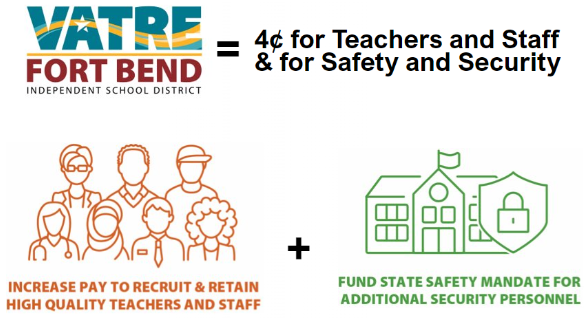VATRE
Page Navigation
- 2023 VATRE Proposition A Information
- VATRE Prop A Frequently Asked Questions
- VATRE Prop A Teacher Pay Scale
- Important VATRE Prop A Dates
- VATRE Prop A in the News
- VATRE Prop A Videos
- VATRE Prop A Print Materials
- VATRE Prop A on Social Media
- VATRE Prop A Ballot Language
- VATRE Prop A Voting Information (Early Voting)
- VATRE Prop A Voting Information
- VATRE Prop A Election Results
- VATRE Prop A Staff Ethics and Guidelines
- Efficiency Audit
How Will FBISD Spend VATRE Prop A Revenues?
Increase Pay to Recruit & Retain High Quality Teachers and Staff
-
- Currently, Fort Bend ISD is $3,000 below peer districts in teacher pay and has one of the lowest starting salaries for new teachers in the region. Prop A provides salary increases for all teachers and staff.
- Due to a teacher shortage, nearly 200 teacher and campus positions went unfilled. To recruit and retain high quality teachers, 70% of generated funds from Prop A will go to increase teacher pay.
- Student to teacher classroom ratios and class sizes can increase when there is a shortage of teachers or less funds in the instructional budget.
➤ See how FBISD VATRE Proposition A will also fund Safety & Security
VATRE Prop A - Increase Pay to Recruit & Retain High Quality Teachers and Staff
-
How will the raises be allocated among employees if the VATRE is successful?
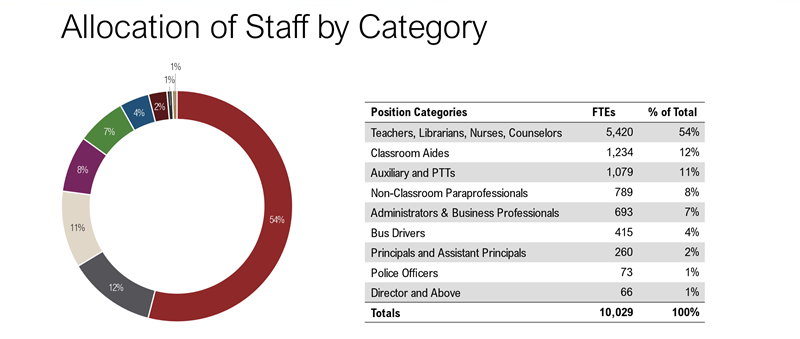
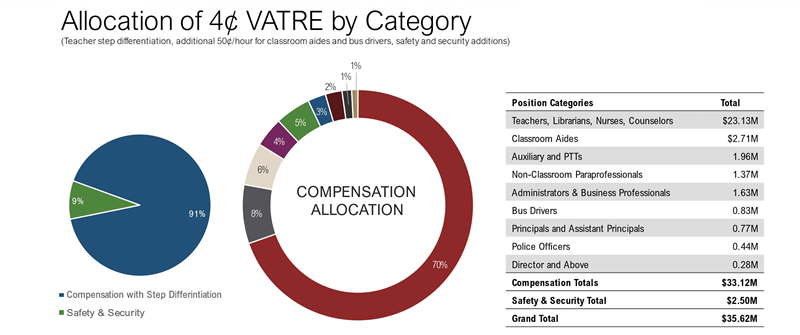
-
Why was FBISD not able to include raises in the budget this year?
Projected student enrollment growth has slowed, inflation has impacted expenditures, increased staffing for Special Education students has been required, innovative academic programs dating back to 2017 have been added, low utilization of campuses, and expiration of government funding received during the pandemic have all contributed to the current financial situation. Additionally, FBISD has historically maintained a low tax rate and has fewer enrichment pennies than peer districts.
Additional information about some of the key causes:
Inflation
Like all families and businesses, FBISD is paying more for fuel, utilities, food, supplies, and labor. Between inflation and the national shortage of labor, all employers must pay more to attract and retain talent.
The basic allotment that school districts receive based on enrollment and attendance has not been adjusted to keep up with inflation. The allotment has not been adjusted since 2019, and would need to be increased by $887 (14.4%) to keep up with inflation. That adjustment did not occur during the legislative session, in spite of a historic state budgetary surplus of $30+ billion.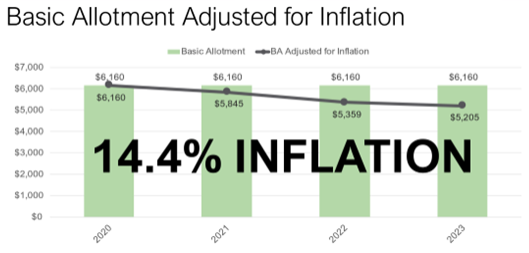
Increased Staff for Special Education:
The District has added 5,146 special education students since 2016. Recent growth in the number of students with special needs has highlighted the inadequate state funding for special education. The District had 9,821 special education students at the end of 2023. The difference between the average cost per student and the average revenue from the state is $3,450 per student per year, therefore the total amount being absorbed by the district as it provides services for Special Education students was $33.5 million last year. The Special Education deficit was $16.2M in 2016: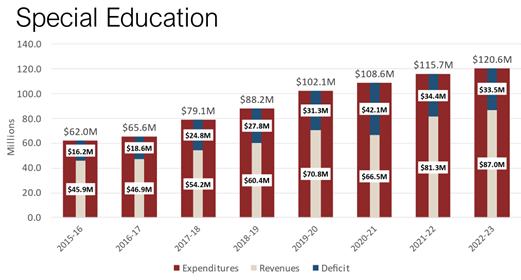
Innovative Academic Programming
Since 2017-18, the District added enrichment programs such as the Early College High School at Marshall High School, P-Tech programs at Hightower and Willowridge High Schools, opened the James Reese Career and Technology Center, to name a few, without increasing taxes.
Low Campus Utilization
The fixed costs associated with maintaining smaller neighborhood schools make it very difficult to allocate more funding for teacher pay or other District needs. Each campus, regardless of enrollment, requires a principal, assistant principal, nurse, counselor, custodians, and other positions that cost roughly $1.4 million.
For the 2023-24 school year, the District has consolidated four campuses into two this year as part of the recent budget cuts. More consolidation is needed and the topic will be part the District’s strategic planning process that will start later this fall. -
How do FBISD raises compare to neighboring districts?
Fort Bend ISD did not offer ongoing staff raises for the 2023-24 school year. A one-time retention supplement of $1,500 for teachers and $1,000 for all other staff was offered, but will not occur in 2024-25. Teachers also received a $500 step increase that occurs annually as part of the teacher step scale based on years of experience.
The District must maintain a competitive compensation package to retain and attract teachers and staff. Having the revenue from the VATRE will allow competitive compensation increases to happen.
Raises over the last three years have not allowed FBISD to keep up with neighboring districts. FBISD gave the following raises over the last three years:- FY2021-22: 6% for teachers; 4% for non-teaching staff ($36 million).
- FY2022-23: 2% for teachers; 2% for non-teaching staff ($14.5 million).
- FY2023-24: $500 step for teachers, no raises for non-teaching staff ($2.7 million).
Even with these increases in salaries, the starting pay for FBISD is $3,000 below our peers.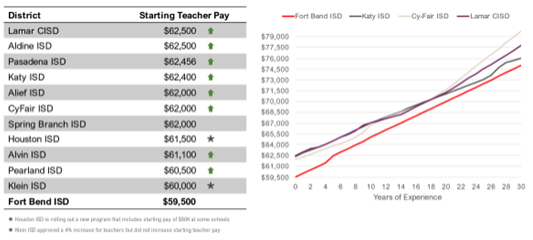
-
How have other districts been able to afford raises, but FBISD is not able to?
As mentioned earlier, FBISD has maintained a low tax rate and has fewer enrichment pennies in the tax rate than our peer districts (see table below).
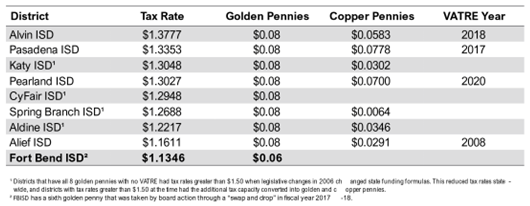
Eight districts in the region have all 8 golden pennies that are allowed by state statute. Seven of the eight districts also have copper pennies (Cy-Fair is the only one without copper pennies).
The value of the 2 golden pennies for FBISD is $25M, and the value of two copper pennies is $10M per year.
Additionally, several districts adopted deficit budgets to help fund salary increases: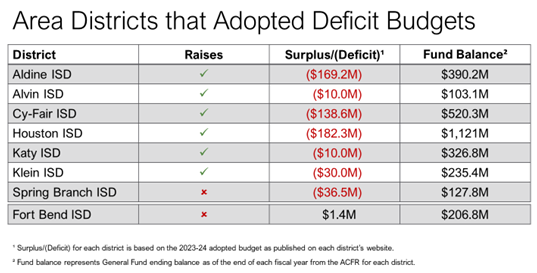
-
What is the differentiated teacher step plan?
Prior to the VATRE, Fort Bend ISD’s P7 Teacher Salary Structure (187/190 calendar) provided a $500 pay increase incrementally each year except for a one-time increase of $1,000 after the completion of Year 5 (Step 6).
The 2023-24 P7 Teacher Salary Structure (187/190 calendar) included in the VATRE expands the differentiation factor to each 5-year milestone up to 25 Completed Years of Service (Step 26).
Teachers on P7 Teacher Salary Structure with different calendar days are paid using the daily rate of this scale.

